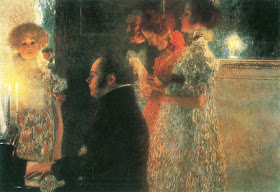 |
| Schubert at the piano, by Gustav Klimt (1899). |
REVIEW
Steven Vanhauwaert, Second Sundays at Two, Rolling Hills United Methodist Church
DAVID J BROWN
If the score of Schubert’s penultimate piano sonata had come down to us with no indication of who’d written it, or when, or even whether it was its author’s only work, there could still be no doubt that he or she was one of the greats. Now add in what we do know—that Schubert was still a young man (but already dying of syphilis), that this was just the centerpiece in a trio of mighty sonatas conceived concurrently, and that even these were but three amongst many masterpieces that he produced in what Benjamin Britten called arguably the “richest and most productive 18 months in our music history.”
While requiring consummate pianism to make their full effect, Schubert’s piano sonatas are not virtuoso showpieces per se. Rather, and in particular these last three, they are spacious tonal structures that can be regarded metaphorically as landscapes comprising many kinds of terrain, or as emotional journeys that encompass everything from unbuttoned joy to anger, anguish, and black pits of depression. To embrace all this, and maintain a steady vision of the whole, is no mean challenge for a performer.
 |
| Steven Vanhauwaert. |
 |
| Despite appearances, this is more likely to have been a life mask than a death mask. |
Many of Schubert’s late slow movements (the Ninth Symphony and Second Piano Trio come particularly to mind) have the overall shape of a calm or contemplative opening that leads to a central crisis and then by degrees back again. What happens in this sonata’s slow movement (deceptively headed Andantino) is the most extreme of them all: “for a few moments it is almost incoherent in its wild intensity,” as the BBC Music Guide says, while for the pianist Mitsuko Uchida it is “the greatest mad scene ever written.” The composer’s despairing rage seems to threaten tonality itself, and defy the ability of his chosen instrument to express it. Mr. Vanhauwaert was as vivid and skilled as any pianist I have heard in the way he stormed up to the edge of the pit, peered into the void, and then drew back slowly to safer ground.
After an incisive account of Schubert’s somewhat spiky Scherzo and brief Trio (no Schubertian “heavenly lengths” here), he gave the expansive Rondo finale all the space that it needs. Perhaps it was the impact of listening to such a fine performance live and with score in hand, but I have never before been so struck by the extent to which this movement’s development section comes quite close to matching that of the slow movement in power, albeit without that almost unhinged intensity. With the final return of the rondo theme, and full value given to the six one-measure rests that punctuate its phrases before the presto conclusion, there was the palpable sense of a long voyage safely brought to harbor. A memorable performance indeed.
 |
| Saint-Saëns at the piano, 1908. |
Before playing No. 1, Op. 21 as a bonne bouche to precede the main item, he remarked on how little-played and little-known Saint-Saëns’ solo piano music still is, and affirmed his love and esteem for it with a most affectionate performance, quite languid and with plenty of rubato in its opening and close, and smiling mock-severity for its central section.
Mazurka No. 2, Op. 24, as encore after a brief chat with RHUMC Music Director Charles Dickerson, proved more dramatic and epigrammatic than its predecessor, punctuated with trills and crisp dotted rhythms, and just a touch of quasi-“oriental” harmony here and there. Maybe these mazurkas are chips off of a master’s workbench, but what a workbench, and what a master!
---ooo---
Rolling Hills United Methodist Church, Sunday, January 13 2019, 2.00 p.m.
Images: Schubert by Klimt: Wikimedia Commons; Steven Vanhauwaert: artist website; Schubert "death mask": Goethe Society; Saint-Saëns: Interlude.

No comments:
Post a Comment
Note: Only a member of this blog may post a comment.